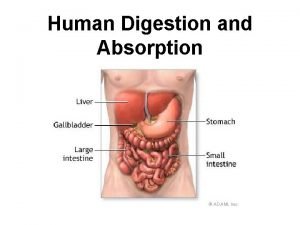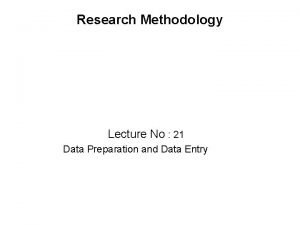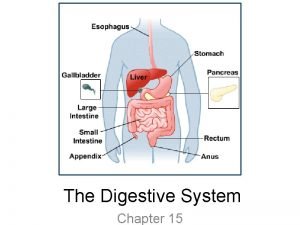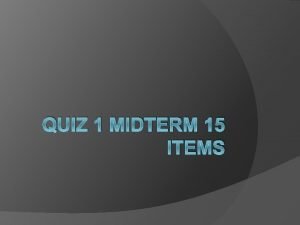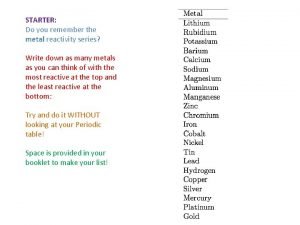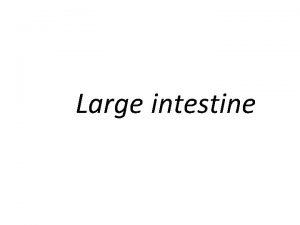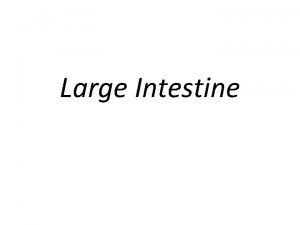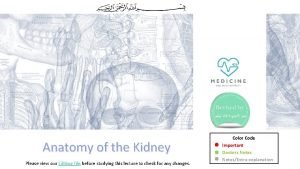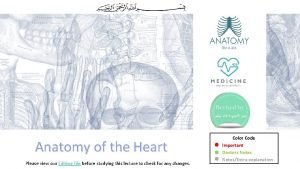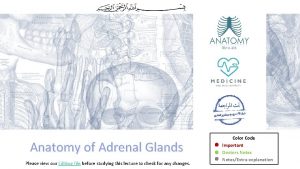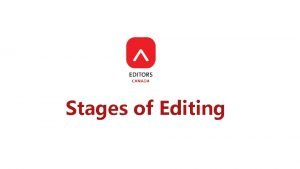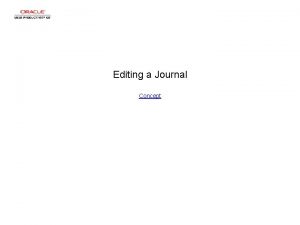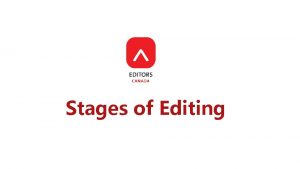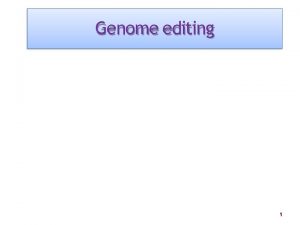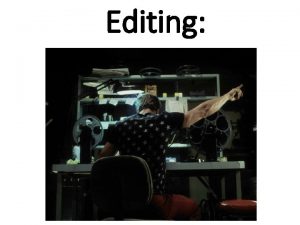Anatomy of Large Intestines Please view our Editing


















- Slides: 18

Anatomy of Large Intestines Please view our Editing File before studying this lecture to check for any changes. Color Code Important Doctors Notes/Extra explanation

Objectives By the end of this lecture the student should be able to: üList the different parts of large intestine. üList the characteristic features of colon. üDescribe the anatomy of different parts of large intestine regarding: the surface anatomy , peritoneal covering , relations, arterial & nerve supply.

Parts of the Large Intestine • (1, 2, 3, 4, 5) are found in the abdomen • (6, 7) are found in the pelvis • (8) is found in the perineum Or anal canal Extra

Characteristics of Colon (NOT found in rectum and anal canal) 1. Taeniae coli: • Three longitudinal muscle bands 2. Sacculations (Haustra): • Because the Taeniae coli are shorter than large intestine 3. Epiploic Appendices : • Short peritoneal folds filled with fat Extra

Peritoneal Covering • Parts with mesentery*: • Retroperitoneal parts**: 1. Transverse colon 1. Ascending colon 2. Sigmoid or pelvic colon 2. Descending colon 3. Appendix 3. Upper 2/3 of rectum • Parts devoid ( )ﺑﺪﻭﻥ of peritoneal covering: 1. Lower 1/3 of rectum 2. Anal canal 4. Cecum * The peritoneum covers the anterior and posterior surfaces. ** The peritoneum only covers the anterior surface Rectum Anal canal

Relations of (CECUM – ASCENDING & DESCENDING COLONS) Anterior: • Greater omentum • Coils of small intestine • Anterior abdominal wall Posterior: Cecum: Psoas major , Iliacus Ascending colon : Iliacus , Quadratus lumborum, Right kidney. Descending colon : Left kidney, Quadratus lumborum , Iliacus, psoas major Quadratus lumborum Coils of small intestine Anterior abdominal wall

COLIC FLEXURES Splenic flexure Position: higher Angle: more acute Hepatic flexure

Relations of Transverse Colon Anterior: greater omentum , anterior abdominal wall Posterior: 2 nd part of duodenum , pancreas & superior mesenteric vessels. Anterior abdominal wall Superior: liver, gall bladder, stomach Inferior: coils of small intestine

Appendix Surface Anatomy Important o The appendix is a lymphoid tissue for immunity. o The base of appendix is marked by Mc. Burney’s point: A point at the junction of lateral 1/3 & medial 2/3 of a line traced from right anterior superior iliac spine to umbilicus. (Its importance lies in the fact that tenderness and rebound at this point is suggestive of appendicitis ) ﻟﻤﺎ ﺍﻟﺪﻛﺘﻮﺭ ﻳﻔﺤﺺ ﺍﻟﻤﺮﻳﺾ ﻳﺤﻂ ﺍﺻﺒﻌﻴﻦ ﻋﻠﻰ ﺍﻟﻤﻜﺎﻥ ﻭﺍﺫﺍ ﺷﺎﻟﻬﺎ ﺑﺴﺮﻋﻪ ﺣﻴﺼﺮﺥ ﺍﻟﻤﺮﻳﺾ ﻣﻦ ﺍﻻﻟﻢ ﺍﺫﺍ ﻛﺎﻧﺖ ﻣﻠﺘﻬﺒﻪ Extra

Extra Appendix o Opening: (opens into cecum) At posteromedial aspect of cecum, 1 inch below ileocecal junction. o Positions: The free end is mobile so it moves and we may find it in the following positions: 1. Retrocecal (most common) 2. Pelvic (may be misdiagnosed with ovavitis) 3. Subcecal (below) 4. Preilieal 5. Postileal (least common) ﻣﻬﻢ ﻧﻌﺮﻓﻬﺎ ﻋﺸﺎﻥ ﺍﺫﺍ ﻛﺎﻥ ﻋﻨﺪﻧﺎ ﺍﻟﺘﻬﺎﺏ ﻓﻲ ﺍﻟﺰﺍﺋﺪﺓ ﻭﺟﺌﻨﺎ ﻧﺒﻲ ﻧﺸﻴﻠﻬﺎ ﺍﻭﻝ ﺷﻴﺀ ﻻﺯﻡ ﻧﺪﻭﺭﻫﺎ ﻭﺭﻯ ﺍﻟﺴﻴﻜﻢ ﺍﺫﺍ ﻣﺎ ﻟﻘﻴﻨﺎﻫﺎ ﻧﺒﺪﺃ ﻧﺪﻭﺭ ﻓﻲ ﺍﻻﻣﺎﻛﻦ ﺍﻟﺜﺎﻧﻴﺔ

Rectum o Beginning: as a continuation of sigmoid colon at level of S 3 in front. o Termination: continues as anal canal, one inch below & in front of tip of coccyx. Its end is dilated to form the rectal ampulla. o Length: 13 cm (5 inches)

Relations of Rectum in Pelvis Male Pelvis • Anterior: seminal vesicles, posterior surfaces of urinary bladder & prostate gland* • Posterior: sacrum, sacral plexus** & coccyx * Due to its relation to the rectum, the easiest way to diagnose prostate enlargement is by examining it per rectal. ** Also prostate cancer may spread backwards and press on the sacral plexus causing symptoms of sciatica Female Pelvis • Anterior: posterior wall of vagina • Posterior: sacrum, sacral plexus & coccyx (posterior relations are the same in male and female)

Relation Between Embryological Origin of GIT& its Arterial Supply GIT is developed from foregut, midgut and hindgut. Each of which has its own blood supply: Foregut from esophagus proximal duodenum at major duodenal papilla Celiac trunk Midgut from distal duodenum after opening right 2/3 of transvers colon Superior mesenteric artery Hindgut from left 1/3 of transvers colon anal canal Inferior mesenteric artery Venous Drainage Of GIT The veins of the gut form the tributaries of the portal vein which enters the liver and drains into the portal circulation.

Lymph Drainage of GIT Only on the girls’ slides • The lymph vessels follow the arteries. • Ultimately, all the lymph is collected at the Preaortic lymph nodes (Superior & Inferior mesenteric). Relation Between Embryological Origin & Nerve Supply Origin: Midgut (endoderm) Nerve supply: (Autonomic): Sympathetic (celiac) + Vagus Origin: Hindgut (endoderm) Nerve supply: (Autonomic): Sympathetic + pelvic splanchnic nerves Origin: ectoderm (lower 1/3 of anal canal) Nerve Supply: Somatic (inferior rectal)

Peritoneal Covering CECUM – ASCENDING & DESCENDING COLONS Transverse Colon APPENDIX Rectum PARTS with MESENTERY: 1. Transverse colon 2. Sigmoid colon 3. Appendix 4. Cecum RETROPERITONEAL PARTS: 1. Ascending colon 2. Descending colon 3. Upper 2/3 of rectum PARTS DEVOID OF PERITONEAL COVERING: 1. Lower 1/3 of rectum 2. Anal canal Anterior Relations: -Greater omentum COLIC FLEXURES: Surface anatomy : the base of appendix is marked by Mc’Burney’spoint. Opening: At posteromedial aspect of cecum. Positions: 1. Retrocecal most common 2. Pelvic 3. Subcecal 4. Preilieal 5. Postileal: least common Beginning: at level of Venous drainage: Portal circulation. S 3. Lymph drainage: Termination: -Coils of small intestine -Anterior abdominal wall Posterior Relations: Cecum: 1. Psoas major 2. Iliacus Ascending colon: 1. Iliacus 2. Quadratus lumborum 3. Right kidney. Descending colon: 1. Left kidney 2. Quadratus lumborum 3. Iliacus 1 -Hepatic flexure 2 -Splenic flexure: higher + more acute angle Relations: Anterior: -greater omentum, anterior abdominal wall. Posterior: -2 nd part of duodenum , -pancreas & -superior mesenteric vessels. Superior: -liver, - gall bladder, stomach Inferior: -coils of small intestine continues as anal canal, one inch below & in front of tip of coccyx. Length: 13 cm(5 inches) Relations Posterior : sacrum , sacral plexus & coccyx Anterior: MALE PELVIS: seminal vesicles, posterior surfaces of urinary bladder & prostate gland. FEMALE PELVIS: posterior wall of vagina. Venous, lymph, nerve supply Preaortic lymph nodes. Nerve supply: Origin: Midgut Nerve supply: (Autonomic): Sympathetic + Vagus Origin: Hindgut Nerve supply: (Autonomic): Sympathetic + pelvic splanchnic nerves Origin: ectoderm (lower 1/3 of anal canal) Nerve Supply: Somatic (inferior rectal)

MCQs 1. The taeniae coli found in which of the following structure ? A- Transverse colon B- Small intestine C- Rectum D- Anal canal 2. Which of the following part is with mesentery ? A- Lower 1/3 of rectum B- Appendix C- Ascending colon D- Upper 2/3 of rectum 3. Which of the following structure is an anterior relation of cecum ? A- Psoas major B- lliacus C- Quadratus lumborum D- Coils of small intestine 4. The superior mesenteric vessels relate to Transverse colon ? A- Anteriorly B- Posteriorly C- Superiorly D- inferiorly 5. Which one of the following is the nerve supply of the Hindgut (endoderm): A- Sympathetic + pelvic splanchnic nerves B- Somatic (inferior rectal) C- Sympathetic + Vagus 6. All the lymph in the GIT is collected at the: A- Preaorticlymph nodes (Superior & Inferior mesenteric). B- Preaorticlymph nodes (anterior & Inferior mesenteric). C- postaorticlymph node 7. The termination of the rectum is: A- as a continuation of sigmoid colon at level of S 3. B- continues as anal canal, one inch below & in front of tip of coccyx. C- sacral plexus & coccyx 8. Which one of the following parts of large intestine is found in the pelvis? A- Transverse colon B- Anal canal C- Rectum D- Cecum 9. Its surface anatomy is marked by Mc’Burney’s point: A- Rectum B- Colon C- Appendix D- Pancreas Answers: 1. A, 2. B, 3. D, 7. B 4. B 8. C 5. A 9. C 6. A

SAQ 1. What are the Characteristics of COLON ? 1) Taeniae coli 2) Sacculations 3) Epiploic appendices 2. What are the Anterior Relations of (CECUM – ASCENDING & DESCENDING COLONS) 1) Anterior abdominal wall 2) Coils of small intestine 3) Greater omentum 3. What are the Posterior Relations (CECUM – ASCENDING & DESCENDING COLONS) • Cecum: 1. Psoas major 2. Iliacus • Ascending colon : 1. Iliacus 2. Quadratus lumborum 3. Right kidney. • Descending colon : 1. Left kidney 2. Quadratus lumborum 3. Iliacus

Leaders: Nawaf Al. Khudairy Jawaher Abanumy Feedback anatomyteam 436@gmail. com @anatomy 436 Members: Alanoud Abuhaimed Anwar Alajmi Ghada Alothaim Lama Alfawzan Lama Al. Tamimi Rawan Al. Wadee Reema Alshayie Safa Al-Osaimi Shatha Alghaihb Wejdan alzaid References: 1 - Girls’ & Boys’ Slides 2 - Greys Anatomy for Students 3 - Teach. Me. Anatomy. com
 Orange juice ph
Orange juice ph Central editing in research methodology
Central editing in research methodology Nonlinear video editing
Nonlinear video editing Mouth esophagus stomach intestines
Mouth esophagus stomach intestines Small intestine
Small intestine Simsposition
Simsposition The primary editing view in powerpoint
The primary editing view in powerpoint Will you please be quiet please summary
Will you please be quiet please summary Reactivity series how to remember
Reactivity series how to remember For further information please visit
For further information please visit Our beloved father
Our beloved father Please read our
Please read our The anatomy of a large scale hypertextual web search engine
The anatomy of a large scale hypertextual web search engine Oogoogle translate
Oogoogle translate Large intestine relations
Large intestine relations Gross anatomy of the large intestine
Gross anatomy of the large intestine The anatomy of a large scale hypertextual web search engine
The anatomy of a large scale hypertextual web search engine The anatomy of a large-scale hypertextual web search engine
The anatomy of a large-scale hypertextual web search engine Large intestine anatomy
Large intestine anatomy
